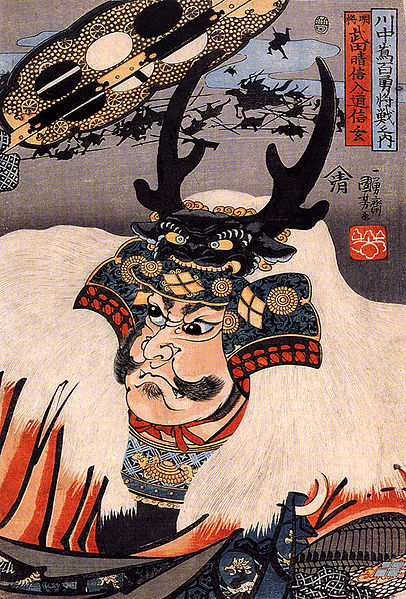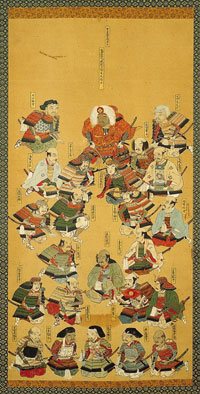<Back to Index>
- Astronomer Nicolas Claude Fabri de Peiresc, 1580
- Painter Karl Schmidt Rottluff, 1884
- Daimyo of Kai Province Takeda Shingen, 1521
PAGE SPONSOR



Takeda Shingen (武田 信玄, December 1, 1521 – May 13, 1573), of Kai Province, was a preeminent daimyo in feudal Japan with exceptional military prestige in the late stage of the Sengoku period.
Shingen was called "Tarō" (a commonly used pet name for the eldest son of a Japanese family) or "Katsuchiyo" (勝千代) during his childhood. When he celebrated his coming of age, he was given a formal name of "Harunobu" (晴信), which included a character from the name of Ashikaga Yoshiharu (足利義晴), the 12th Ashikaga Shogun. It was a common practice in feudal Japan for a higher ranked warrior to bestow a character from his own name to his inferiors as a symbol of recognition. From the local warlord's perspective, it was glorious to receive a character from the shogunate, although the authority of the latter had greatly degenerated in the mid 16th century.
Both the Ashikaga and the Takeda clans descended from the noble Minamoto (源) clan. Technically, Harunobu, as well as his forefathers, had borne the surname of Minamoto. Therefore, Harunobu would be referred to as "Minamoto-no Harunobu" (源晴信) in official records kept by the Imperial Court when he was conferred the official title of "Daizen Dayu" (大膳大夫). The Imperial Court had maintained a system of ritsuryō (律令) that was parallel to the shogunate apparatus.
In 1559 Harunobu chose to live a pabbajja life and received a dharma name, Shingen (信玄), from his Buddhist master. The kanji of "Shingen" can also be pronounced as "Nobuharu," which is the inversion of his official name, Harunobu. In ancient times, such stylish / religious names of recognized Japanese aristocrats / warriors / officials would be read in "onyomi" (音読み), the Chinese styled pronunciation, instead of "kunyomi" (訓読み), the indigenous Japanese pronunciation. Although widely known by the dharma name, Takeda Shingen's formal name remained "Harunobu" throughout the rest of his life.
Shingen is sometimes referred to as "The Tiger of Kai" (甲斐の虎) for his martial prowess on the battlefield. His primary rival, Uesugi Kenshin (上杉謙信), was often called "The Dragon of Echigo" (越後の龍) or also "The Tiger of Echigo" (越後の虎). Takeda Shingen was the first born son of Takeda Nobutora (武田信虎), leader of the Takeda clan, and daimyo of the province of Kai.
He had been an accomplished poet in his youth. He assisted his father
with the older relatives and vassals of the Takeda family, and became
quite a valuable addition to the clan at a fairly young age. But at
some point in his life after his "coming of age" ceremony, the young
man decided to rebel against his father. He
finally succeeded at the age of 21, successfully taking control of the
clan. Events regarding this change of leadership are not entirely
clear, but it is thought that his father had planned to name the second
son, Takeda Nobushige,
as his heir instead of Shingen. The end result for the father was a
miserable retirement that was forced upon him by his son and his
supporters: he was sent to Suruga Province (駿河) (on the southern border of Kai) to be kept in custody under the scrutiny of the Imagawa clan, led by Imagawa Yoshimoto (今
川義元), the daimyo of Suruga. For their help in this bloodless coup, an
alliance was formed between the Imagawa and the Takeda clans.
Shingen's first act was to gain a hold of the area around him. His goal was to conquer Shinano Province (信州). A number of the major daimyos in the Shinano region marched on the border of Kai Province,
hoping to neutralize the power of the still young Shingen before he had
a chance to expand into their lands. However, planning to beat him down
at Fuchu (where word had it Shingen was gathering his forces for a
stand), they were unprepared when Takeda forces suddenly came down upon
them at the battle of Sezawa.
Taking advantage of their confusion, Shingen was able to score a quick
victory, which set the stage for his drive into Shinano lands that same
year. The young warlord made considerable advances into the region,
conquering the Suwa headquarters in the siege of Kuwabara before
moving into central Shinano with the defeat of both Tozawa Yorichika
and Takato Yoritsugu. However, the warlord was checked at Uetahara by Murakami Yoshikiyo,
losing two of his generals in a heated battle which Murakami won.
Shingen managed to avenge this loss and the Murakami clan was
eventually defeated. Murakami fled the region, eventually coming to
plead for help from the Province of Echigo (越後).
After
he had conquered Shinano, Shingen faced another rival, Nagao Kagetora
(長尾景虎) or later Uesugi Masatora (政虎) / Terutora (輝虎) / Kenshin of Echigo.
The feud between them became almost legendary, and they faced each
other on the battlefield five times at the battles of Kawanakajima.
These battles were generally confined to controlled skirmishes, neither
daimyo willing to devote himself entirely to a single all out attempt.
The conflict between the two that had the fiercest fighting, and might
have decided victory or defeat for one side or the other, was the
fourth battle, during which the famous tale arose of Uesugi Kenshin's
forces clearing a path through the Takeda troops and Kenshin engaging
Shingen in single combat. The tale has Kenshin attacking Shingen with
his sword while Shingen defends with his iron war fan or tessen. Both lords lost many men in this fight, and Shingen in particular lost two of his main generals, Yamamoto Kansuke and his younger brother Takeda Nobushige. After
the fourth battle of Kawanakajima, Takeda clan suffered two internal
setbacks. Shingen uncovered two plots on his life, the first from his
cousin Katanuma Nobumoto (whom he ordered to commit seppuku), and the second, a few years later, from his own son Takeda Yoshinobu (武
田義信). His son was confined to the Tokoji, where he died two years
later; it is not known whether his death was natural or ordered by his
father. After this incident, Shingen designated his fourth son, Takeda Katsuyori (武
田勝頼), as the acting leader of the clan after himself until Katsuyori's
son came of age. Katsuyori himself, however, never became the formal
head of the clan. The
death of Yoshinobu is believed to have much to do with the change in
Shingen's Imagawa policy. After Imagawa Yoshimoto's death in a battle
against Oda Nobunaga (織田信長) in 1560, Shingen had started to plan an invasion of Suruga, a territory now controlled by Yoshimoto's son Ujizane.
Yoshinobu, however, had strongly opposed such a plan because his wife
was the daughter of late Yoshimoto. By 1567, nonetheless, after Shingen
had successfully kept the forces led by Uesugi Kenshin out of the northern boundaries of Shinano, taken over a strategically important castle in western Kōzuke,
and suppressed internal objection to his plans to take advantage of the
weakened Imagawa clan, he was ready to carry out his planned Suruga
invasion. During this time Shingen also ordered the damming project of the Fuji River, which was one of the major domestic activities of the time. Shingen and Tokugawa Ieyasu (徳
川家康) are believed to have made a pact to share the remaining Imagawa
lands between them, and they both fought against Yoshimoto's heir.
After defeating the intervention forces commanded by Hōjō Ujimasa (北條氏政) of Sagami, Shingen finally secured the Province of Suruga, formerly base of the prestigious Imagawa clan, as a Takeda asset in 1569. Upon
securing Takeda control over Suruga, northern Shinano, and western
Kōzuke, Shingen moved to challenge the Oda - Tokugawa alliance, leading a
formidable force of over 30,000 into the latter's territories in Tōtōmi, Mikawa and Mino Provinces in 1572. The
exact circumstances surrounding Takeda Shingen's death are not
absolutely known. There are many different stories, some of which are
as follows. When Takeda Shingen was 49 years old, he was the only daimyo with the necessary power and tactical skill to stop Oda Nobunaga's rush to rule Japan. He engaged Tokugawa Ieyasu's forces in 1572 and captured Futamata, and in January engaged in the battle of Mikatagahara,
where he defeated, but not decisively, a small combined army of
Nobunaga and Ieyasu. After defeating Tokugawa Ieyasu, Shingen stopped
his advance temporarily due to outside influences, which allowed
Tokugawa to prepare for battle again. He entered Mikawa Province, but
soon died in the camp. Some accounts say he succumbed to an old war
wound, some say a sniper wounded him earlier, and some accounts say he
died of pneumonia. He was buried at Erin temple in what is now Kōshū, Yamanashi. The film Kagemusha,
by director Akira Kurosawa, loosely depicts a well known version of his
death in which a single sniper shot him at night. The other aspects of
his death depicted in the film were artistic liberties taken by the
director. Takeda Katsuyori became
the daimyo of the Takeda clan. Katsuyori was ambitious and desired to
continue the legacy of his father. He moved on to take Tokugawa forts.
However an allied force of Tokugawa Ieyasu and Oda Nobunaga dealt a
crushing blow to the Takeda in the Battle of Nagashino. Here Oda Nobunaga's matchlock - armed infantry destroyed the Takeda cavalry. Ieyasu seized the opportunity and defeated the weak Takeda led by Takeda Katsuyori in the battle of Temmokuzan. Katsuyori committed suicide after the battle, and the Takeda clan never recovered. Upon
Shingen's death, Kenshin reportedly cried at the loss of one of his
strongest and most deeply respected rivals. One of the most lasting tributes to Shingen's prowess was that of Tokugawa Ieyasu himself,
who is known to have borrowed heavily from the old Takeda leader's
governmental and military innovations after he had taken leadership of
Kai during Toyotomi Hideyoshi's rise to power. Many of these designs were put to use in the Tokugawa Shogunate. While
the Takeda were for the most part destroyed by the loss of Shingen's
heir, Katsuyori, Shingen had a profound effect on the period in Japan.
He influenced many lords with his law, tax, and administration systems,
and many tales were told about him. Although aggressive towards
military enemies he was probably not as cruel as other warlords. His
war banner contained the famous phrase Fū-Rin-Ka-Zan (風林火山 "Wind, Forest, Fire, Mountain"), taken from Sun Tzu's 'The Art of War.' This phrase refers to the idea of Swift as the Wind, Silent as a Forest, Fierce as Fire and Immovable as a Mountain. The motto applied to Shingen's policies and his military strategy.
During the Edo period, 24 retainers who served under Shingen were chosen as a popular topic for Ukiyo-e and Bunraku.
The names vary from work to work. They had not worked together, as some had
died before others served, but they were noted for their exceptional contributions to Shingen and the Takeda family. Of his retainers, Kōsaka Masanobu stands out as being one of Shingen's better known beloveds, in the style of the Japanese shudo tradition. The two entered into the relationship when Shingen was 22 and Masanobu 16. The love pact signed by the two, in Tokyo University's
Historical Archive, documents Shingen's pledge that he was not involved
in, nor had any intentions of entering into, a sexual relationship with
a certain other retainer, and asserts that "since I want to be intimate
with you" he will in no way harm the boy, and calls upon the gods to be
his guarantors.
The Takeda Shingen festival takes place on the first weekend of every April in Kōfu. Usually a famous Japanese TV actor plays the part of Takeda Shingen himself. There are several parades going to and from the Takeda Shrine and Kofu Castle.
These parades are very theatrical involving serious re-enactors who
practice the rest of the year for this one weekend in April. The
parades reflect the different comings and goings of Takeda Shingen
during his life.